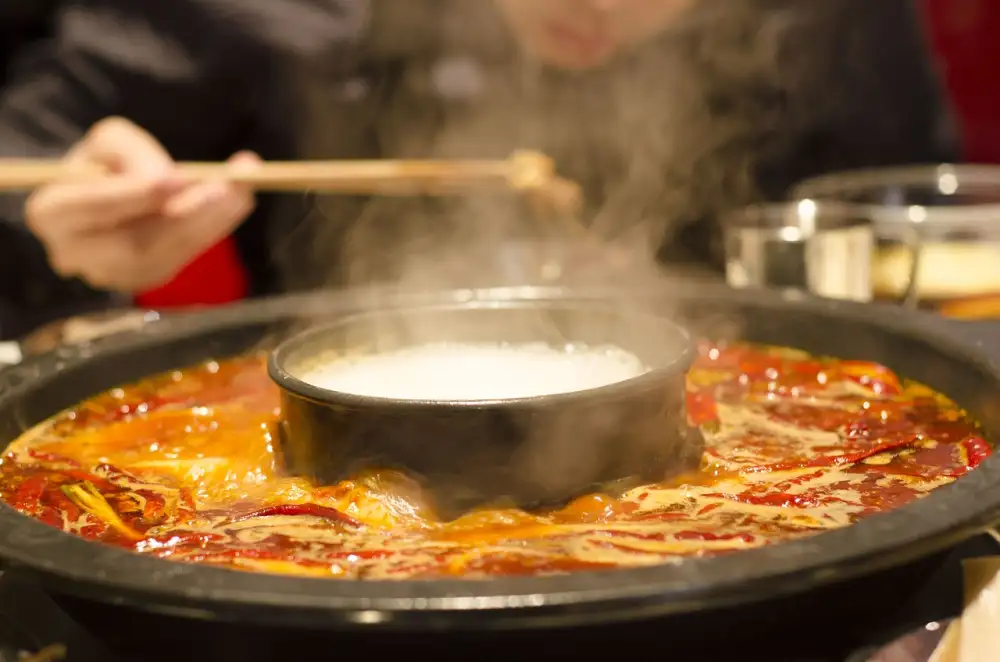Hotpot: Unleash Your Culinary Creativity with this Authentic Chinese Cooking Method

- History of Hotpot: Tracing its Origins and Cultural Significance
- Ingredients for Hotpot: A Wide Array of Choices to Suit Every Palate
- Hotpot Soup Bases: Enhancing Flavors with a Variety of Broths
- Hotpot Cooking Techniques: Simmering, Boiling, and Dipping
- Hotpot Accompaniments: Dipping Sauces and Side Dishes for a Complete Experience
- Hotpot Etiquette: Tips for Enjoying Hotpot with Family and Friends
- Health Benefits of Hotpot: Nourishing and Nutritious Ingredients for a Balanced Meal
- Hotpot Variations: Exploring Regional and International Adaptations
- Hotpot Recipes: Step-by-Step Instructions to Create Your Own Hotpot Feast
Hotpot is a traditional Chinese cooking method that has gained popularity worldwide. It involves simmering a variety of ingredients in a flavorful broth at the table, creating a communal and interactive dining experience. This culinary art form allows individuals to customize their meals by selecting their preferred ingredients and cooking them to perfection. Whether you're a meat lover, seafood enthusiast, or vegetarian, hotpot offers endless possibilities to satisfy every palate. Join us on a journey as we delve into the rich history, diverse ingredients, and unique techniques of hotpot cooking. Get ready to unleash your culinary creativity with this authentic Chinese cooking method!
History of Hotpot: Tracing its Origins and Cultural Significance
Hotpot, also known as Chinese fondue, has a rich history that dates back over 1,000 years. Its origins can be traced to the Jin Dynasty in China. Initially, hotpot was a way for nomadic tribes to cook their food by boiling it in a communal pot over an open fire.
Over time, hotpot evolved and became popular among the general population. It spread throughout China and gained cultural significance as a social and family-oriented meal. Hotpot gatherings became a way for people to come together, bond, and share stories while enjoying a delicious meal.
Hotpot's cultural significance extends beyond China. It has become a beloved culinary tradition in other Asian countries such as Japan, Korea, and Thailand. Each region has its own unique variations of hotpot, showcasing the diversity and adaptability of this cooking method.
Today, hotpot continues to be cherished for its communal nature and the opportunity it provides for people to connect with one another over a shared dining experience. Its long history and cultural significance make hotpot not just a meal but also an important part of Chinese culinary heritage.
Ingredients for Hotpot: A Wide Array of Choices to Suit Every Palate
When it comes to hotpot, the possibilities are endless. The beauty of this Chinese cooking method lies in its versatility, allowing you to choose from a wide array of ingredients to suit every palate. From succulent meats like thinly sliced beef, tender lamb, and fresh seafood such as shrimp and fish balls, to an assortment of vegetables including leafy greens, mushrooms, and tofu, there is something for everyone. For those seeking a spicy kick, add in some chili peppers or Sichuan peppercorns. And for those who prefer a milder flavor profile, opt for more delicate herbs like cilantro or green onions. With so many options available, you can truly unleash your culinary creativity and customize your hotpot experience to your liking.
Hotpot Soup Bases: Enhancing Flavors with a Variety of Broths
One of the key elements that make hotpot so delicious is the flavorful soup base. The soup base serves as the foundation for the entire hotpot experience, infusing each ingredient with its unique taste. There are numerous options when it comes to selecting a hotpot soup base, allowing you to customize your meal according to your preferences.
Traditional hotpot soup bases include clear broth, spicy Sichuan broth, and mushroom broth. Clear broth is light and refreshing, perfect for highlighting the natural flavors of the ingredients. Spicy Sichuan broth, on the other hand, adds a fiery kick to the hotpot and is loved by those who enjoy bold and spicy flavors. Mushroom broth offers a rich and earthy taste, adding depth to the overall dish.
In addition to these classic choices, there are also innovative options available such as tomato-based broths or seafood-infused broths. These variations provide a different dimension to your hotpot experience, allowing you to explore new flavors and combinations.
To enhance the flavors even further, many people like to add aromatic herbs and spices to their soup bases. Common additions include ginger slices, garlic cloves, star anise, cinnamon sticks, and dried chili peppers. These ingredients infuse their essence into the broth as it simmers away during the cooking process.
Whether you prefer a mild or spicy soup base, there is no shortage of options when it comes to enhancing your hotpot with flavorful broths. Experimenting with different combinations can lead to exciting discoveries and help you create a truly personalized hotpot feast that will impress your family and friends.
Hotpot Cooking Techniques: Simmering, Boiling, and Dipping
Hotpot cooking involves three main techniques: simmering, boiling, and dipping. Simmering is the gentlest method, where ingredients are cooked slowly in the hot broth to infuse them with flavor. Boiling, on the other hand, is a more rapid technique that cooks ingredients quickly while retaining their natural textures. Lastly, dipping allows diners to cook their own ingredients by placing them in the broth for a short time before enjoying them. These techniques allow for a dynamic and interactive dining experience that brings out the best flavors in each ingredient.
Hotpot Accompaniments: Dipping Sauces and Side Dishes for a Complete Experience
To truly elevate your hotpot experience, it is essential to have an array of dipping sauces and side dishes. These accompaniments not only add flavor but also provide a variety of textures to complement the hotpot ingredients.
For dipping sauces, there are endless possibilities. Traditional options include soy sauce, sesame oil, garlic, and chili paste. You can also experiment with combinations of vinegar, ginger, spring onions, and even peanut butter for a unique twist.
Side dishes play a crucial role in enhancing the overall hotpot experience. Popular choices include thinly sliced meats such as beef or lamb, seafood like shrimp or squid, and an assortment of vegetables like mushrooms, tofu, and leafy greens. These ingredients can be cooked directly in the hotpot or separately prepared as side dishes.
Remember to keep the side dishes simple yet flavorful to allow the main focus to remain on the hotpot itself. The goal is to create a harmonious balance between the dipping sauces, side dishes, and the flavors of the hotpot broth.
By offering a wide selection of dipping sauces and side dishes, you can cater to different taste preferences and ensure that everyone at the table has a complete and satisfying hotpot experience. So get creative with your choices and let your culinary imagination run wild!
Hotpot Etiquette: Tips for Enjoying Hotpot with Family and Friends
When it comes to enjoying hotpot with family and friends, there are a few etiquette tips to keep in mind. First, it is customary to let the host or elder guests start cooking the ingredients in the pot. This shows respect and appreciation for their efforts.
Next, remember to cook small portions at a time to ensure that everyone gets a chance to try different ingredients. It's also important to use separate utensils for raw and cooked food to prevent cross-contamination.
In terms of dipping sauces, feel free to experiment and create your own unique blend. However, avoid double-dipping your utensils into the communal sauce bowls as this can spread germs.
Lastly, hotpot is meant to be a social experience, so take your time and enjoy the meal together. Engage in conversation, share stories, and savor each bite. Remember, hotpot is not just about the food but also about creating lasting memories with loved ones.
Health Benefits of Hotpot: Nourishing and Nutritious Ingredients for a Balanced Meal
Hotpot is not only a delicious and satisfying meal, but it also offers numerous health benefits. The wide array of ingredients used in hotpot ensures a balanced and nutritious meal. Fresh vegetables like leafy greens, mushrooms, and tofu provide essential vitamins and minerals. Lean meats such as thinly sliced beef or chicken add protein without excessive fat. Seafood options like shrimp and fish are rich in omega-3 fatty acids, promoting heart health. Additionally, the simmering broth helps retain the nutrients of the ingredients, making hotpot a wholesome choice for a nourishing meal.
Hotpot Variations: Exploring Regional and International Adaptations
While hotpot originated in China, it has evolved and adapted in various regions and countries, offering unique flavors and ingredients. In Sichuan, the famous "Mala" hotpot is known for its spicy and numbing broth, packed with Sichuan peppercorns and chili peppers. In Guangdong, a lighter version called "Yin Yang" hotpot combines a clear soup base with a spicier one.
Internationally, hotpot has gained popularity with adaptations such as Japanese shabu-shabu, where thinly sliced beef or pork is swirled in a delicate kombu-based broth. In Korea, they have their own version called "Jeongol," featuring an assortment of meat, seafood, and vegetables cooked in a flavorful soybean paste broth.
In Thailand, "Suki" hotpot is enjoyed with a tangy and sweet dipping sauce made from lime juice, chili peppers, and peanuts. Even Western countries have embraced the hotpot trend with variations like cheese fondue or bouillabaisse-style seafood hotpots.
These regional and international adaptations showcase the versatility of hotpot as it continues to captivate taste buds around the world. Whether you prefer bold flavors or subtle nuances, there's a hotpot variation out there waiting to be explored.
Hotpot Recipes: Step-by-Step Instructions to Create Your Own Hotpot Feast
1. Spicy Sichuan Hotpot: Start by preparing a spicy broth with Sichuan peppercorns, chili oil, and garlic. Add thinly sliced beef, lamb, and vegetables like cabbage and mushrooms. Dip in a tangy soy sauce-based dipping sauce for an explosion of flavors.
2. Seafood Hotpot: Create a seafood lover's delight by simmering a seafood broth with prawns, fish fillets, clams, and squid. Add in vegetables like bok choy and bean sprouts for freshness. Pair it with a zesty ginger and spring onion dipping sauce.
3. Vegetarian Hotpot: For the herbivores, prepare a vegetable broth with carrots, potatoes, tofu, and assorted greens. Enhance the flavors with soy sauce and sesame oil. Serve with a peanut-based dipping sauce for added richness.
4. Korean Kimchi Hotpot: Give your hotpot an extra kick by using kimchi as the base for your broth. Add pork belly slices, tofu, enoki mushrooms, and kimchi dumplings for an authentic Korean twist. Enjoy it with a spicy gochujang dipping sauce.
5. Thai Tom Yum Hotpot: Transport yourself to Thailand with this aromatic hotpot recipe. Simmer lemongrass, galangal, kaffir lime leaves in chicken or vegetable broth. Add shrimp, mushrooms, and glass noodles for a complete meal experience.
6. Japanese Shabu-Shabu: This classic Japanese hotpot requires thinly sliced beef or pork cooked in kombu-infused dashi broth. Dip the meat into ponzu sauce or sesame sauce before enjoying it alongside vegetables like napa cabbage and shiitake mushrooms.
7. Mongolian Lamb Hotpot: Indulge in the rich flavors of Mongolia by simmering lamb shoulder slices in a hearty lamb broth. Add potatoes, carrots, and onions for a satisfying meal. Savor it with a savory sesame dipping sauce.
With these recipes, you can unleash your culinary creativity and customize your hotpot feast according to your preferences. Experiment with different ingredients, flavors, and dipping sauces to create a truly unique and delicious hotpot experience.
In conclusion, hotpot is not just a cooking method, but an art form that allows you to unleash your culinary creativity. With its rich history, wide array of ingredients, and diverse soup bases, hotpot offers endless possibilities for creating unique and flavorful dishes. By mastering the various cooking techniques and experimenting with different accompaniments and dipping sauces, you can truly personalize your hotpot experience. So gather your family and friends, embrace the art of hotpot, and let your culinary creativity soar!
Published: 08. 12. 2023
Category: Food



